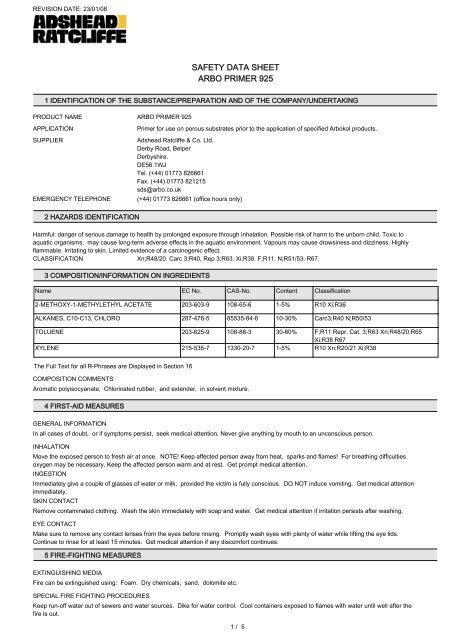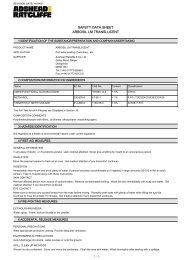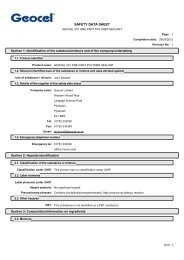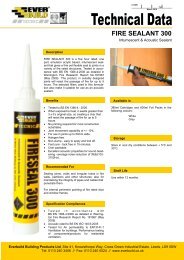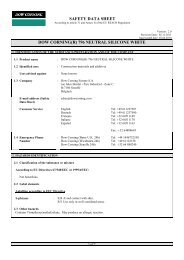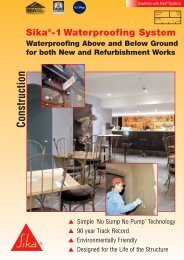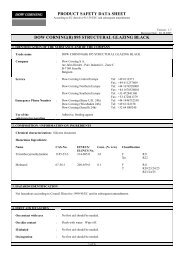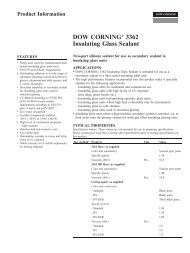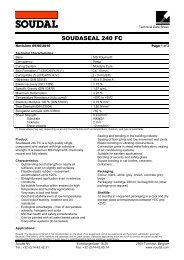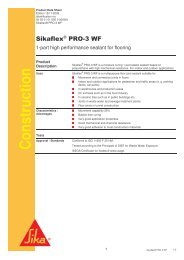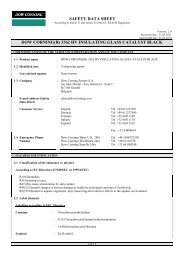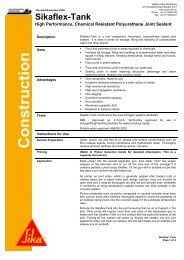Create successful ePaper yourself
Turn your PDF publications into a flip-book with our unique Google optimized e-Paper software.
REVISION DATE: 23/01/08SAFETY DATA SHEETARBO PRIMER <strong>925</strong>1 IDENTIFICATION OF THE SUBSTANCE/PREPARATION AND OF THE COMPANY/UNDERTAKINGPRODUCT NAME ARBO PRIMER <strong>925</strong>APPLICATIONSUPPLIEREMERGENCY TELEPHONE<strong>Primer</strong> for use on porous substrates prior to the application of specified <strong>Arbo</strong>kol products.Adshead Ratcliffe & Co. Ltd.Derby Road, BelperDerbyshire.DE56 1WJTel. (+44) 01773 826661Fax. (+44) 01773 821215sds@arbo.co.uk(+44) 01773 826661 (office hours only)2 HAZARDS IDENTIFICATIONHarmful: danger of serious damage to health by prolonged exposure through inhalation. Possible risk of harm to the unborn child. Toxic toaquatic organisms, may cause long-term adverse effects in the aquatic environment. Vapours may cause drowsiness and dizziness. Highlyflammable. Irritating to skin. Limited evidence of a carcinogenic effect.CLASSIFICATION Xn;R48/20. Carc 3;R40, Rep 3;R63. Xi;R38. F;R11. N;R51/53. R67.3 COMPOSITION/INFORMATION ON INGREDIENTSNameEC No.CAS-No.ContentClassification2-METHOXY-1-METHYLETHYL ACETATE203-603-9108-65-6 1-5%R10 Xi;R36ALKANES, C10-C13, CHLORO287-476-585535-84-8 10-30%Carc3;R40 N;R50/53TOLUENEXYLENE203-625-9215-535-7108-88-3 30-60%1330-20-7 1-5%F;R11 Repr. Cat. 3;R63 Xn;R48/20,R65Xi;R38 R67R10 Xn;R20/21 Xi;R38The Full Text for all R-Phrases are Displayed in Section 16COMPOSITION COMMENTSAromatic polyisocyanate, Chlorinated rubber, and extender, in solvent mixture.4 FIRST-AID MEASURESGENERAL INFORMATIONIn all cases of doubt, or if symptoms persist, seek medical attention. Never give anything by mouth to an unconscious person.INHALATIONMove the exposed person to fresh air at once. NOTE! Keep affected person away from heat, sparks and flames! For breathing difficultiesoxygen may be necessary. Keep the affected person warm and at rest. Get prompt medical attention.INGESTIONImmediately give a couple of glasses of water or milk, provided the victim is fully conscious. DO NOT induce vomiting. Get medical attentionimmediately.SKIN CONTACTRemove contaminated clothing. Wash the skin immediately with soap and water. Get medical attention if irritation persists after washing.EYE CONTACTMake sure to remove any contact lenses from the eyes before rinsing. Promptly wash eyes with plenty of water while lifting the eye lids.Continue to rinse for at least 15 minutes. Get medical attention if any discomfort continues.5 FIRE-FIGHTING MEASURESEXTINGUISHING MEDIAFire can be extinguished using: Foam. Dry chemicals, sand, dolomite etc.SPECIAL FIRE FIGHTING PROCEDURESKeep run-off water out of sewers and water sources. Dike for water control. Cool containers exposed to flames with water until well after thefire is out.1 / 5
REVISION DATE: 23/01/08UNUSUAL FIRE & EXPLOSION HAZARDSARBO PRIMER <strong>925</strong>May travel considerable distance to source of ignition and flash back. May explode when heated or when exposed to flames or sparks. Vapourexplosion and poison hazard indoors, outdoors and in sewers.SPECIFIC HAZARDSIrritating gases/vapours/fumes of Carbon dioxide (CO2). Carbon monoxide (CO).6 ACCIDENTAL RELEASE MEASURESPERSONAL PRECAUTIONSWear appropriate protective clothing. Avoid inhalation of vapours and contact with skin and eyes. In case of spills, beware of slippery floorsand surfaces.ENVIRONMENTAL PRECAUTIONSDo not allow to enter drains, sewers or watercourses.SPILL CLEAN UP METHODSClean-up personnel should use respiratory and/or liquid contact protection. Extinguish all ignition sources. Avoid sparks, flames, heat andsmoking. Ventilate. Collect with non-combustible absorbent material. Flush with water. Dike for large spills. Inform Authorities if large amountsare involved.7 HANDLING AND STORAGEUSAGE PRECAUTIONSKeep away from heat, sparks and open flame. Avoid spilling, skin and eye contact. Ventilate well, avoid breathing vapours. Use approvedrespirator if air contamination is above accepted level. Wear full protective clothing for prolonged exposure and/or high concentrations.STORAGE PRECAUTIONSFlammable/combustible - Keep away from oxidisers, heat and flames. Store in tightly closed original container in a dry, cool and well-ventilatedplace. May attack some plastics, rubber and coatings. Ground container and transfer equipment to eliminate static electric sparks.STORAGE CLASSFlammable liquid storage.8 EXPOSURE CONTROLS/PERSONAL PROTECTIONName2-METHOXY-1-METHYLETHYL ACETATETOLUENEXYLENEStdLT - ppm LT - mg/m3 ST - ppm ST - mg/m3WEL 50 ppm(Sk) 274 mg/m3(Sk) 100 ppm(Sk) 548 mg/m3(Sk)WEL 50 ppm(Sk) 191 mg/m3(Sk) 100 ppm(Sk) 384 mg/m3(Sk)WEL 50 ppm(Sk) 220 mg/m3(Sk) 100 ppm(Sk) 441 mg/m3(Sk)INGREDIENT COMMENTSWEL = Workplace Exposure LimitsPROTECTIVE EQUIPMENTENGINEERING MEASURESProvide adequate general and local exhaust ventilation. Must not be handled in confined space without sufficient ventilation.RESPIRATORY EQUIPMENTNo specific recommendation made, but respiratory protection must be used if the general level exceeds the Recommended WorkplaceExposure Limit.HAND PROTECTIONUse protective gloves made of: Butyl rubber.EYE PROTECTIONWear approved safety goggles.OTHER PROTECTIONUse engineering controls to reduce air contamination to permissible exposure level. Provide eyewash, quick drench. Wear appropriateclothing to prevent any possibility of skin contact.HYGIENE MEASURESDO NOT SMOKE IN WORK AREA! Wash at the end of each work shift and before eating, smoking and using the toilet. Wash promptly withsoap & water if skin becomes contaminated. Promptly remove any clothing that becomes contaminated. Use appropriate skin cream toprevent drying of skin. When using do not eat, drink or smoke.2 / 5
REVISION DATE: 23/01/08ARBO PRIMER <strong>925</strong>9 PHYSICAL AND CHEMICAL PROPERTIESAPPEARANCELiquidCOLOURStrawODOURAromatic.SOLUBILITYInsoluble in waterBOILING POINT (°C) 111 RELATIVE DENSITY 1.15 @ 20"CVISCOSITY 550 - 700 cps @ 20" C FLASH POINT (°C) 4AUTO IGNITION480 FLAMMABILITY LIMIT - LOWER(%) 1.3TEMPERATURE (°C)FLAMMABILITY LIMIT - UPPER(%) 710 STABILITY AND REACTIVITYSTABILITYStable under normal temperature conditions and recommended use.CONDITIONS TO AVOIDAvoid contact with oxidisers or reducing agents. Avoid heat, flames and other sources of ignition.MATERIALS TO AVOIDNITRIC ACIDHAZARDOUS DECOMPOSITION PRODUCTSFire creates: Vapours/gases/fumes of: Carbon monoxide (CO). Carbon dioxide (CO2).11 TOXICOLOGICAL INFORMATIONTOXIC DOSE 1 - LD 50Toluene: 5000 mg/kg (oral rat)TOXICOLOGICAL INFORMATIONThe product has been assessed following the conventional method of the Dangerous Preparations Directive 1999/45/EC and classified fortoxicological hazards accordingly.INHALATIONHarmful: danger of serious damage to health by prolonged exposure through inhalation. Vapours may cause headache, fatigue, dizziness andnausea.INGESTIONNarcotic effect.SKIN CONTACTIrritating to skin. Acts as a defatting agent on skin. May cause cracking of skin, and eczema.EYE CONTACTIrritating to eyes.HEALTH WARNINGSPreparation contains small volumes of isocyanate which may cause allergic reaction and irritation of respiratory system.Other Health EffectsCarcinogen Category 3. Toxic to Reproductive Health Categ. 3.MEDICAL SYMPTOMSExtreme irritation of eyes and mucous membranes, including burning and tearing. Severe skin irritation. Nausea, vomiting. Central nervoussystem depression. Drowsiness, dizziness, disorientation, vertigo. Pulmonary oedema, frothy sputum.12 ECOLOGICAL INFORMATIONECOTOXICITYThere are no data on the ecotoxicity of this product. Dangerous for the environment: May cause long-term adverse effects in the aquaticenvironment.LC 50, 96 Hrs, FISH mg/l Toluene: 34EC 50, 48 Hrs, DAPHNIA, mg/l Toluene: 60MOBILITYThe product is insoluble in water.13 DISPOSAL CONSIDERATIONS3 / 5
REVISION DATE: 23/01/08ARBO PRIMER <strong>925</strong>DISPOSAL METHODSDispose of waste and residues in accordance with local authority requirements.Do not allow runoff to sewer, waterway or ground.14 TRANSPORT INFORMATIONPROPER SHIPPING NAMEPAINT RELATED MATERIAL. MARINE POLLUTANT (C10 - C13 chlorinated paraffin)UN NO. ROAD 1263ADR CLASS NO.3ADR PACK GROUP IIHAZARD No. (ADR)33ADR LABEL NO.3HAZCHEM CODE3[Y]ECEFIC TEC(R) NO. 30G80RID CLASS NO.3UN NO. SEA 1263IMDG CLASS3IMDG PACK GR. IIEMS3-05MARINE POLLUTANT UN NO. AIR1263AIR CLASS3AIR PACK GR.II15 REGULATORY INFORMATIONLABELLINGCONTAINSHarmful Highly Flammable Dangerous for theenvironmentALKANES, C10-C13, CHLOROTOLUENERISK PHRASESR11R38R40Highly flammable.Irritating to skin.Limited evidence of a carcinogenic effect.R48/20 Harmful: danger of serious damage to health by prolonged exposure through inhalation.R63Possible risk of harm to the unborn child.R51/53 Toxic to aquatic organisms, may cause long-term adverse effects in the aquaticenvironment.R67Vapours may cause drowsiness and dizziness.SAFETY PHRASESS16Keep away from sources of ignition - No smoking.S36/37 Wear suitable protective clothing and gloves.S51S60S61P4Use only in well-ventilated areas.This material and its container must be disposed of as hazardous waste.Avoid release to the environment. Refer to special instructions/safety data sheets.Contains isocyanates. See information supplied by the manufacturer.4 / 5
REVISION DATE: 23/01/08STATUTORY INSTRUMENTSARBO PRIMER <strong>925</strong>Chemicals (Hazard Information and Packaging) Regulations. Control of Substances Hazardous to Health.APPROVED CODE OF PRACTICEClassification and Labelling of Substances and Preparations Dangerous for Supply.GUIDANCE NOTESWorkplace Exposure Limits EH40. CHIP for everyone HSG(108).16 OTHER INFORMATIONREVISION COMMENTSRevised sections: 8.REVISION DATE 23/01/08REV. NO./REPL. SDS GENERATED 23/08/05SDS NO. 10158RISK PHRASES IN FULLR10R11R20/21R36R38R40R48/20R50/53R63R65R67Flammable.Highly flammable.Harmful by inhalation and in contact with skin.Irritating to eyes.Irritating to skin.Limited evidence of a carcinogenic effect.Harmful: danger of serious damage to health by prolonged exposure through inhalation.Very toxic to aquatic organisms, may cause long-term adverse effects in the aquatic environment.Possible risk of harm to the unborn child.Harmful: may cause lung damage if swallowed.Vapours may cause drowsiness and dizziness.DISCLAIMERThis information relates only to the specific material designated and may not be valid for such material used in combination withany other materials or in any process. Such information is, to the best of the company's knowledge and belief, accurate andreliable as of the date indicated. However, no warranty guarantee or representation is made to its accuracy, reliability orcompleteness. It is the user's responsibility to satisfy himself as to the suitability of such information for his own particular use.5 / 5


